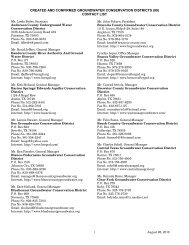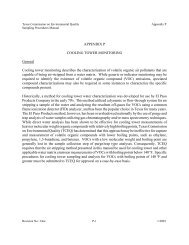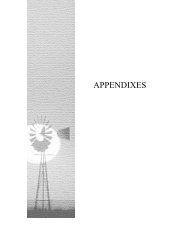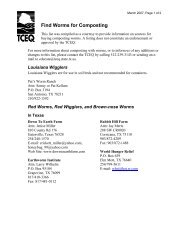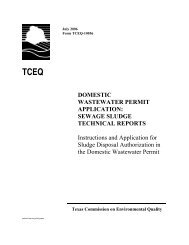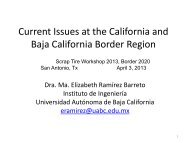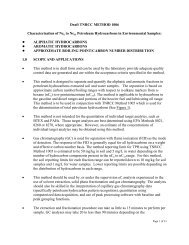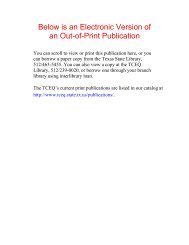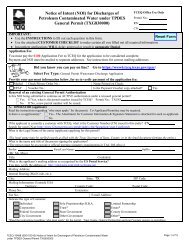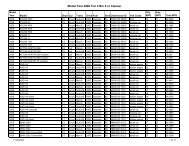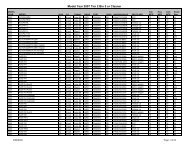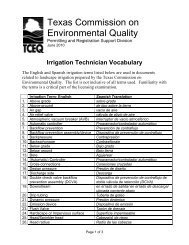Ecological Overlay for the Trinity River for support of Development of ...
Ecological Overlay for the Trinity River for support of Development of ...
Ecological Overlay for the Trinity River for support of Development of ...
Create successful ePaper yourself
Turn your PDF publications into a flip-book with our unique Google optimized e-Paper software.
Table 6. List <strong>of</strong> aquatic species identified in <strong>the</strong> Texas Comprehensive Wildlife Conservation Strategy that<br />
are found in <strong>the</strong> <strong>Trinity</strong> <strong>River</strong> basin but not originally nominated by TPWD biologists.<br />
Species Status Known Host Spawning Season Stressor Notes<br />
MacNeeses crayfish<br />
Fallicamberus<br />
macneesei<br />
Steigmans Crayfish<br />
Procambarus<br />
steigmani<br />
Bigclaw <strong>River</strong><br />
Shrimp<br />
Macrobrachium<br />
carcinus<br />
Creeper Mussel<br />
Stophitus undulatus<br />
Texas emerald<br />
dragonfly<br />
Somatochlora<br />
margarita<br />
Fishes<br />
American eel<br />
SC NA Spawning usually in<br />
September (early fall),<br />
egg release normally in<br />
April (spring)<br />
SC NA Spawning usually in<br />
September (early fall),<br />
egg release normally in<br />
April (spring)<br />
SC NA Probably carry eggs in<br />
March to September.<br />
SC Largemouth<br />
bass, creek chub,<br />
green sunfish<br />
July to April and May;<br />
may not need fish host<br />
SC NA Very little known about<br />
biology or larval habitat.<br />
Defined as vulnerable by AFS<br />
due to narrow range and<br />
sensitivity to pollution, habitat<br />
change and modified flow<br />
regimes, only found close to<br />
coastal areas within 50 miles<br />
According to AFS this species is<br />
in imminent danger <strong>of</strong> extinction<br />
or extirpation throughout large<br />
portion <strong>of</strong> range. Found in <strong>the</strong><br />
extreme nor<strong>the</strong>rn portion <strong>of</strong> <strong>the</strong><br />
<strong>Trinity</strong> Basin, lives in higher<br />
elevation riparian prairie<br />
Dams limit upstream migration<br />
<strong>of</strong> juveniles. Adults migrate to<br />
freshwater and release hatched<br />
larvae.<br />
Found many sites, but rare not<br />
seen in state <strong>of</strong> Texas since<br />
1992, rated stable by AFS.<br />
Limited in Texas to a few<br />
counties adjacent to <strong>the</strong> <strong>Trinity</strong><br />
<strong>River</strong> and E. Texas. Endemic to<br />
two states in <strong>the</strong> United States<br />
(Louisiana and Texas). The<br />
species currently is known from<br />
six counties in <strong>the</strong>se two states.<br />
This species has a restricted<br />
range (currently only seven<br />
locations are known).<br />
SC NA Jan to August in mid- Dams impede upstream<br />
Anguilla rostrata<br />
Atlantic - Catadromous movement <strong>of</strong> juveniles<br />
Blue sucker ST NA Late April to May Abundance <strong>of</strong> Cycleptus elongatus<br />
Cycleptus elongatus<br />
has been decreased by<br />
impoundment, pollution, and<br />
reduced water flows in those<br />
systems in which it occurs.<br />
Creek chubsucker<br />
Erimyzon oblongus<br />
ST NA March to May Not listed by AFS.<br />
Sabine shiner SC NA May to December N. sabinae was designated a<br />
Notropis sabinae<br />
species <strong>of</strong> conservation concern in<br />
Texas and Louisiana by U.S.<br />
Forest Service Region 8 and U.S.<br />
Fish and Wildlife Service<br />
Region 2, and as a species <strong>of</strong><br />
special concern in Mississippi<br />
Sources: (Abbott 2006; Bender et al. 2005; Bonner 2009; Hobbs III 2001; Howells 2009; Howells et al. 1996; Jelks<br />
et al. 2008; Johnson and Johnson 2008; Kondratieff 2000; Taylor et al. 2007) X = Recent Occurrences (within last<br />
30 years); Status: TWAP-SC = Species <strong>of</strong> Concern, TPWD Texas Wildlife Action Plan 2005 1 = State Rank (S1) –<br />
Critically imperiled, extremely rare, very vulnerable to extirpation, 5 or fewer occurrences 2 = State Rank (S2) –<br />
Imperiled in state, vulnerable to extirpation, 6 to 20 occurrences 3 = Proposed <strong>for</strong> Federal Listing<br />
37<br />
Environmental Institute <strong>of</strong> Houston<br />
November 17, 2009<br />
<strong>Trinity</strong> <strong>River</strong> Basin<br />
Biological <strong>Overlay</strong>



